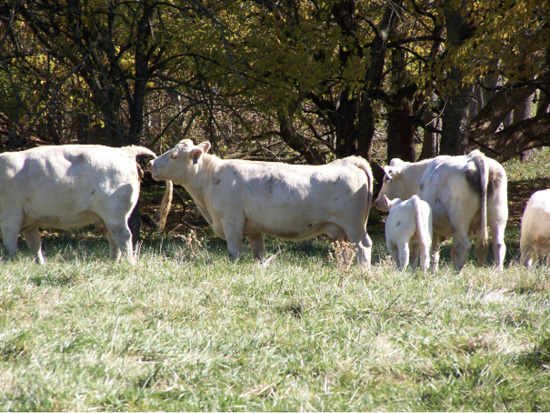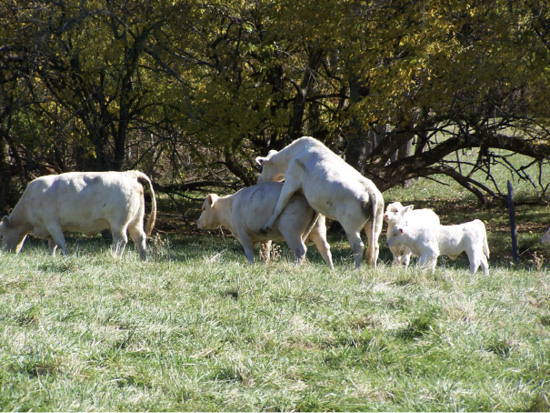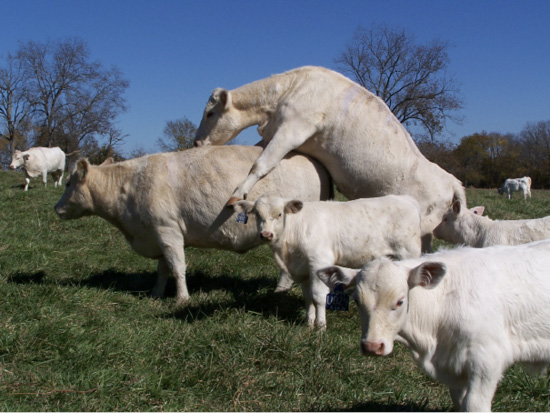Estrus (Heat) Detection in Cattle
Estrus in cattle is commonly referred to as heat. It occurs every 18 to 24 days in sexually mature, open (nonpregnant) female cattle when they are receptive to mounting activity by bulls or other cows or heifers.
Heat detection is critical to heat synchronization and breeding programs, particularly artificial insemination and embryo transfer programs. Effective heat detection is often the most limiting factor in an artificial insemination program. Heat detection can also be used to monitor onset of puberty in heifers, regularity of estrous cycles in breeding age females, and breeding effectiveness of natural service sires via returns to heat in the cow herd.
Heat detection efficiency (rate) is the percentage of eligible cows seen or detected in heat. Eligible cows are cows eligible for insemination. Heifers have reached puberty if they have resumed normal estrus function (cycling) after calving (typically 40 days or more postcalving), are free of reproductive disorders or reproductive tract infections, and are open. A heat detection rate of 80 to 85 percent should be attainable.
Heat Signs and Detection Methods
Several methods of heat detection can be implemented. Some involve using heat detection aids. Several different methods can be combined to improve heat detection rates and accuracy. These include visual observation, heat mount detectors, tailhead markers (paint, chalk, crayon, paste), chin-ball markers, detector animals, and electronic heat detection devices.
Visual Observation
Visual observation is a commonly used method of heat detection. It involves a trained observer’s recognizing and recording signs of heat. Observable signs of heat include mounting or attempting to mount other cattle, standing to be mounted by other cattle, smelling other females, trailing other females, bellowing, depressed appetite, nervous and excitable behavior, mud on hindquarters and sides of cattle, roughed up tail hair, vulva swelling and reddening, clear vaginal mucous discharge, and mucous smeared on rump.
The surest sign of heat is when a cow or heifer allows other cattle to mount her while she remains standing. This is called standing heat. Cattle may be willing to mount others but may not stand to be mounted when outside of standing heat. This usually indicates she is either coming into or going out of standing heat.
This method requires observation of cattle at least twice daily, typically early in the morning and late in the evening for best results. More frequent observation of cattle for heat improves detection accuracy and increases the likelihood of recognizing the optimal time for breeding cattle, particularly in cattle in which heat is less intense or shorter in duration. Nearly 20 percent more cattle will be observed in heat when checked four times per day versus checking twice daily. Check cattle as often as practical. Space heat detection observation times evenly over 24 hours. Each observation period must be sufficiently long, usually at least 30 minutes, to be effective.
Standing heat can occur any time in a 24-hour period. However, the most likely time for a cow or heifer to show heat signs is at night. The season of the year can influence this, with more cows showing heat at night in hot weather and more showing heat during the day in cold weather. Housing conditions can also have an effect on the distribution of heat during a 24-hour period. Hot weather, high production, crowded conditions, and high stress environments may reduce mounting activity.
Observers must distinguish among cattle coming into heat, in standing heat, and going out of heat. Females that are in standing heat, were in standing heat yesterday, or will be in standing heat tomorrow are the most likely herd mates to mount other cows or heifers in heat. Observe cows away from the feed bunk so feeding behavior does not interfere with heat detection. Cattle need nonslip footing and ample room to interact freely. Dirt footing increases mounting and standing activity more than concrete footing.
Heat Detection Aids
Heat detection aids are available. They should be used to supplement but not replace visual observation. These include tail paint, Kamar Heatmount Detectors, Estrotect Heat Detectors, Bovine Beacon, tail head markers, chin-ball markers, and the HeatWatch II System, an electronic detection system that records mounting behavior. Heat detection aids differ in their application method, detection method, cost per animal, and detection accuracy.
Detector (teaser) animals can also assist in heat detection. Teaser animals include several types of gomer bulls, which are surgically altered to prevent successful insemination. Select gomer bulls that will not become excessively large. Acceptable disposition and freedom from disease are also important in gomer bulls.
Management Considerations
Good management is important for a successful heat detection program. Animals must have clearly readable, unique identification. An adequate area and equipment for heat detection must be available. This may include binoculars or the ability to approach cattle very closely. Nighttime observations may require artificial lighting, such as security lights, flashlights, or lanterns. Recordkeeping supplies such as paper, writing utensils, and clocks are important, along with a well-organized recordkeeping system.
People detecting heat must be well trained in heat detection and recording. Instruct all people detecting heat to record cow or heifer ID, time of observation, and all signs of heat observed. Record all heat periods detected, even if the cow or heifer will not be bred on that heat. Then breeding wheels, calendars, or heat expectancy charts can be used to help predict future heats.
Summary
The effectiveness of detecting heat in cattle varies, depending on method used. Consider the cost, labor, and management system associated with each method in deciding on the best approach to heat detection. The purpose of heat detection also determines the level of heat detection accuracy needed. For more information on cattle reproduction or related topics, contact your local MSU Extension county office.
Timeline for Heat Signs in Cattle
Coming into Heat (8 hours)
- Stands and bellows
- Smells other cows
- Headbutts other cows
- Attempts to ride other cows but will not stand to be mounted
- Red, moist, slightly swollen vulva
- Clear mucous discharge from vulva
Standing Heat (18 hours)
- Stands to be mounted
- Rides other cows
- Bellows frequently
- Nervous and excitable
Going out of Heat (14+ hours)
- Attempts to ride other cows but will not stand to be mounted
- Smells other cows
- Clear mucous discharge from vulva
|
Time |
Cows showing heat signs, % |
|---|---|
|
6 a.m. to noon |
22 |
|
noon to 6 p.m. |
10 |
|
6 p.m. to midnight |
25 |
|
midnight to 6 a.m. |
43 |
Source: Cornell University



|
Detection Aid |
Application1 |
Detection Method |
Management Considerations |
Approximate Cost |
|---|---|---|---|---|
|
Kamar Heatmount Detector |
Apply with separate adhesive between tail head and hip bone over the sacrum of cow. |
Detector remains white until triggered by weight of mounting animal, then it turns bright red. |
Detectors may become partially activated, making it hard to tell if heat has occurred. Detectors can become dislodged from female. |
$1–$2/head |
|
Estrotect Heat Detector |
Apply with self- adhesive between tail head and hip bone over the sacrum of cow or heifer. |
Detector remains silver until friction of mounting animal(s) reveals fluorescent color under scratched- off silver layer. |
Low branches, gates, and other cattle can lead to a false positive. Detectors can become dislodged from female. |
$1–$2/head |
|
Bovine Beacon |
Glue to tail head of cow or heifer. |
Contains fluorescent dye that glows in the dark when cow or heifer is mounted by another animal. |
Low branches, gates, and other cattle can lead to a false positive. Detectors can become dislodged from female. |
$1–$2/head |
|
Tail Head Markers |
Smear liberal amounts (at least 2–3” wide) of crayon,chalk, paste, or paint marker on the tail head of cow or heifer. |
When marker is rubbed off tail head (hair will be ruffled and pulled back), the cow or heifer has stood to be mounted. |
Low branches, gates, other cattle, humidity, and rain can lead to a false positive. May need to reapply every few days. |
Less than $1/head |
|
Chin-Ball Marker |
Fit marker device under the chin of a teaser (gomer) bull or androgenized cow or heifer. |
An animal wearing the device mounts and slides off the cow or heifer in heat, leaving an ink mark on the back and hip of female. |
Maintenance is necessary for continuous use (ink must be refilled). Harness straps may break or stretch. Some markings may be from chin’s resting instead of mounting. |
$70–90/harness $30–40/gallon ink |
|
HeatWatch II |
Place small, digital radio transmitter in a piece of polyester material (patch) and glue onto the tailhead of cow or heifer. |
Every time there is a mount, data are sent from that transmitter to a small radio receiver (base station) in the proximity of the heat detectionarea. Mount data include the female mounted, date and duration (in seconds) of each mount. |
Patches can become dislodged from females. Transmitters can fall out of patches if not adequately secured. Batteries must have proper charge. Increased heat detetion accuracy over other aids.
|
$3,950/HeatWatch II System (base station, access paint, software) $945/repeater $49/monitor $3.75/patch $3.75/10.5-oz caulking tube of glue $0.028/volatile corrosion inhibitor (VCI) bag |
1Comb application area first to remove dead or shedding hair.
|
Teaser Animal |
Procedure |
Advantages |
Disadvantages |
|---|---|---|---|
|
Penile-Blocked Bull |
Veterinarian installs device. |
Allows normal mounting. Prevents extension of penis and breeding. Helps prevent spread of venereal diseases. |
Effective for only one year, since bulls tend to lose sex drive. Not frequently available. |
|
Vasectimized Bull |
Surgical procedure severing the vas deferens (tubes that carry sperm from testes to penis), causing sterility. |
Normal libido. Breeding stimuli by sterile bulls increases conception rate to AI. |
Risk of venereal disease spread. |
|
Prepuce/Penis-Deviated Bull |
Redirection of the prepuce and penis; moving the prepuce to one side prevents the penis from lining up with the vulva, thus preventing breeding. |
Better for detecting females in heat than either vasectomized or penile-blocked males. Prevents spread of venereal disease. No loss of sex drive, thus longer work life. |
In some cases, bulls may be able to copulate. |
|
Caudal-Epididymectomized Bull |
Removal of epididymis tail to prevent sperm from reaching the penis. |
Relatively simple to perform. Economical method of preparing a teaser bull. |
Risk of venereal disease spread. |
|
Androgenized Female |
Testosterone propionate injections before the breeding season or Synovex H implants. |
Longer work life. Safer than bulls. Injections are cheaper than surgically altering bull. |
Response to treatment can vary. |
References
Britt, J. H., R. G. Scott, J. D. Armstrong, and M. D. Whitacre. 1986. Determinants of estrous behavior in lactating Holstein cows. J. Dairy Sci. 69:2195-2202.
Hall, J. G., C. Branton, and E. J. Stone. 1959. Estrus, estrous cycles, ovulation time, time of service, and fertility of dairy cattle in Louisiana. J. Dairy Sci. 42:1086-1094.
Hurnik, J. F., King, G. J. and H. A. Robertson. 1975. Estrous and related behaviour in postpartum Holstein cows. Appl. Anim. Ethol. 2:55-68.
The information given here is for educational purposes only. References to commercial products, trade names, or suppliers are made with the understanding that no endorsement is implied and that no discrimination against other products or suppliers is intended.
Publication 2610 (POD-10-21)
By Jane A. Parish, PhD, Professor and Head, North Mississippi Research and Extension Center; Jamie E. Larson, PhD, Professor, Animal and Dairy Sciences; and Rhonda C. Vann, PhD, Research Professor, Animal and Dairy Sciences.
The Mississippi State University Extension Service is working to ensure all web content is accessible to all users. If you need assistance accessing any of our content, please email the webteam or call 662-325-2262.





